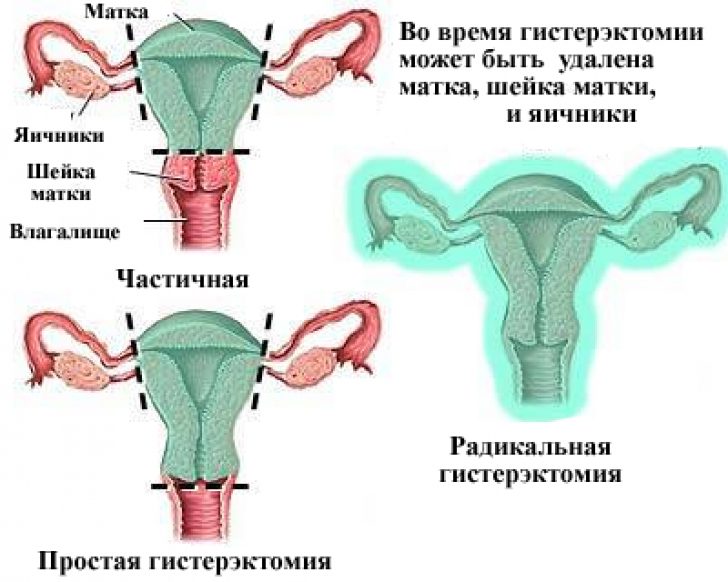What is stage zero cervical cancer? Cancer in the cervical region is a malignant tumor on the mucous membrane. This type of neoplasm is the second most common after breast cancer. Nearly half a million new cases of illness are diagnosed every year, most of them at the last stage, when there is little to no cure. If the disease is diagnosed at an early stage, then the pathology of the cervix can be successfully cured.
About the disease
The diagnosis - cancer, always scares patients, but one should not despair. The most important thing is to choose the right medicine and method, according to experts in the field of medicine, any stage can be cured if everything is done correctly. Of course, the psychological mood of the patient is very important. If the patient has a desire to fight for her life, then it will be easier to cope with the disease, and this has long been proven by scientists. Self-hypnosis and self-control can defeat any infection you just need to want!
Causes of cervical cancer

As a rule, the cause of this pathology is a genetic change in the structure of cells.
Therefore, doctors do not have an exact answer to this question that invokes this process. However, there are some assumptions.
- The papillomavirus usually leads to abnormal or even abnormal tissue development. The lack of medical care will certainly cause the transition of the pathology to a malignant neoplasm.
- The herpes virus causes mutations that lead to the subsequent formation of tumors.
- Venereal diseases.
- Early sexual contacts lead to great disturbances in cells that have not yet fully formed.
- Many casual sexual partners, such behavior changes the microflora and disrupts the structure of cells.
- Injuries of the cervix, which can occur in connection with the birth of a child, during rough sexual contact.
- Uncontrolled use of COCs inevitably leads to changes in hormone levels, changes in microflora and causes the formation of cancer cells.
- The protein type of sperm is able to cause structural modifications in epithelial cells.
- According to experts, the cause of cancer can be the abuse of cigarettes. This factor is not direct, but we can say indirect. Because
- Pathology of the cervix may be associated with the presence of other problems in the body.
stages

There are several basic levels of cervical disease. Histological classifications distinguish several types of neoplasms:
- The squamous type causes, as a rule, pathological modifications in the cells of the epithelium of the genital organs.
- Glandular cancer.
- Non-keratinized type.
- Horny tumor.
The zero stage with timely diagnosis gives an almost 100% guarantee for the complete recovery of the patient in a short period of time.
The first stage is treated longer, since at this stage the tumor often grows into the tissue of the cervix up to 5 mm;
The second phase - the neoplasm takes place in one third of the lower part of the vagina.
The third phase - the nodes extend already to the upper half of the vagina. As a result, kidney failure develops.
The fourth phase is the most difficult, as the pathology extends to bladder, rectum, pelvic bones. At this (last) stage, metastases already appear, which are difficult to remove.

At first, the symptoms are practically absent and it is difficult to detect them by chance. The main symptoms are:
- Weakness and fatigue;
- poor appetite;
- Strong sweating;
- Dry skin;
- Temperature;
- Mass loss.
Features of cervical cancer are:
- Blood discharge (this is a sign of the occurrence of pathological nodes, while the doctor usually diagnoses cervical cancer);
- Pain during sex;
- Bleeding;
- Prolonged and painful menstruation;
- Purulent discharge;
- Unattractive appearance;
- Pain in the back, abdomen, rectum, thighs or buttocks (these symptoms indicate that the tumor has begun to grow into other parts of the body);
- Edema of the extremities, genitals (typical at a later date and is a violation in the genitourinary system);
- Problem with urination (associated with the pressure of the tumor on the bladder or the development of the so-called hydronephrosis);
- Intestinal dysfunction and painful act of defecation;
- blood in the urine;
- At the penultimate stage, complications often occur in the form of: peritonitis, uremia and other diseases.

At the first appointment with the doctor, the patient will undergo a gynecological examination. This is necessary in order to take a smear. Identification of changes in the mucosa is necessary to find out the cause of the disease, and at what stage it is. The essence of this technique is the histological examination of a tissue sample.
If the diagnosis is confirmed, the doctor performs a colposcopy: for this, the mucous membrane is checked using a special endoscope.
Methods of treatment

Timely therapy against this disease will be effective if everything is done correctly and on time.
Here are the main options that are commonly used for problems in the cervix.
- Heat therapy
- Removal of the affected areas and the cervix by surgery.
- laser radiation
- Removal of the damaged part of the epithelium with liquid nitrogen.
- Removal of the tumor with ultrasound.
- remote therapy.
- intracavitary method.
- If the tumor has grown to a depth of no more than three millimeters, the uterus is removed without its appendages.
- If the tumor is severe, the uterus is completely removed. After surgery, radiation therapy is certainly prescribed.
- When the tumor has managed to “throw” metastases to neighboring tissues, a joint operation is usually performed with the removal of the ovaries and other parts of the metastasis.
The fourth phase of malignancy already requires palliative surgery to reduce symptoms. Metastases to other organs are usually treated with chemotherapy.
Radiation therapy

Such a pathology can be treated by any methods, however, radiotherapy is considered the most effective. Its effectiveness depends primarily on the phase of the disease, the age category of the patient and the chosen treatment tactics, of course, everything is selected purely individually.
There are two main techniques that doctors often use.
- Remote (a tumor is affected by a gamma or beta beam). It is produced in two main steps. First, they affect the primary tumor formation, and then all the affected organs and lymph nodes;
- Intracavitary therapy (they use capsules with special radio waves that have a destructive effect). The treatment is complex and it is necessary to start with radium.
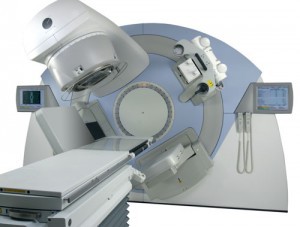
Today, chemotherapy successfully fights such pathologies and is considered the most effective in late forms of malaise. This method is used when the operation did not bring the desired result. The full treatment period is 10 courses, each of which uses a variety of drugs. Such treatment is prescribed mainly to women at the age when they have a postmenopausal period, since such drugs kill healthy cells, which has a bad effect on the body.
With timely detection of the disease, the prognosis is usually positive. However, the non-invasive type of disease responds better to almost any of the above methods. You should know that the disease can only be detected on an outpatient examination by a doctor. This once again confirms the effectiveness of a timely visit to the doctor.

If a malignant neoplasm is found in the third more severe form, the prognosis, of course, is not comforting, and the survival rate of such people is 60%, but if the treatment is chosen correctly. Diagnosis of cervical cancer at the fourth stage, unfortunately, guarantees the survival of patients only eight percent.
Sometimes precedents are diagnosed in patients in the first months of conception. In this case, if there are reasons, the doctor suggests an abortion.
However, if the conception takes place naturally, and there is no threat to the unborn child, the specialist will perform an excision of the vagina, and a caesarean delivery will be performed within the allowed time.
These activities are only allowed in the first three months. In other cases, specialists adhere to expectant tactics, and all "work" is carried out only after the birth of the baby. Today's preventive measures are aimed at early diagnosis and high-quality treatment of cervical cancer. Compliance with personal hygiene in the genital area, the use of contraception can reduce the risk of getting such a pathology.
Do not be afraid of this diagnosis, even if you have confirmed this disease, you do not need to give up and give up on yourself in advance. You need to start fighting for your life and well-being, follow all the instructions of your doctor. Keep your own treatment diary, such a table will help you figure out how much you have been through and what else needs to be done to achieve positive result. The table will help you properly conduct therapeutic treatment and not miss a single doctor's appointment.
How to prevent the development of this disease
 The following preventive measures are recommended:
The following preventive measures are recommended:
- Get tested regularly for viral infections.
- Consume more fruits and vegetables, according to experts, they inhibit the growth of cancer cells.
- Onions and garlic are also excellent anti-cancer agents.
- As a preventive measure, you can periodically drink multivitamins every 6 months.
- Pharmacy tincture of propolis, it is recommended to drink pharmacy tincture.
- Eat bones from cherries, plums, bird cherry, it is in the bones that vitamin B17 is contained, which is antitumor.
- Visit a gynecologist as often as possible, since this ailment does not initially show symptoms.
- There is also a vaccination against this disease, you can try this option.
Cervical cancer is increasingly diagnosed in women of two age categories - 35-40 years and 55-65 years. It is a malignant lesion of the cervix, which is formed against the background of typical precancerous conditions - and neoplasia. These are pathological changes in the epithelium at the cellular level of the cervix, and in 90% of cases they are provoked. If not treated, precancerous conditions quickly transform into two types of cancer - squamous (90%) and glandular (10%). Every year, cervical cancer is diagnosed in more than 500,000 patients in the country.
At the same time, modern medicine has greatly succeeded in treating this pathology and gives a chance for a full cure at almost any of its stages (the percentage of recovery after cervical cancer treatment reaches 70%). The earlier cancer is detected, the higher the chances of the patient.

Causes of cervical cancer
Science does not indicate the exact causes of cancer, but highlights provoking factors that are directly related to its appearance:
- papillomavirus (16 and 18 strains);
- elderly age;
- reception for a long time;
- pathology of the genital organs;
- pregnancy at a very young age (before 16 years);
- a large number of sexual partners;
- artificial abortions;
- viral diseases;
- early sexual life;
- smoking;
- trauma to the cervix during childbirth;
- carcinogens;
- work disruption.
note: the most important factor is the long-term influence of viral infections (herpes,) that affect the cervix and live in its mucous membrane. Viruses cause mutations that are a favorable background for dysplasia and as a result of cancerous degeneration.
Cervical cancer: stages
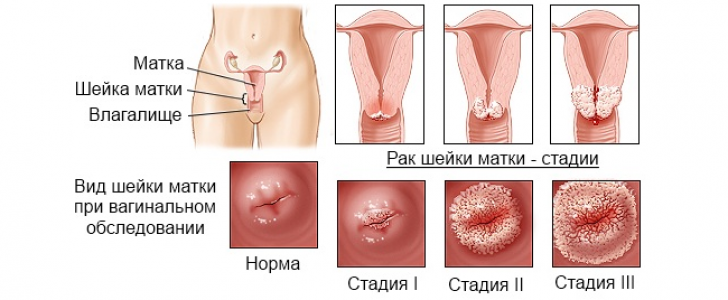
The process of transition of a precancerous condition to cervical cancer takes a different time and can last from 2 to 14 years. From the moment of formation of the zero stage to 4, it takes from 1 to 2 years. At first, the neoplasm will spread to the neck itself, and then it grows into neighboring organs. At the same time, with the flow of lymph, cancer cells spread throughout the body and metastases are formed.
stage 0 cervical cancer
With it, tumor cells affect the upper epithelial layer, which is characterized as preinvasive cancer. This is an intraepithelial cancer that does not grow into the basement membrane of the epithelium and is successfully treated by removing the pathological part of the cervix.
stage 1 cervical cancer
In this case, the cancerous tumor penetrates into the stroma of the cervix, but not deeper. This stage is also treated by excision of the affected area.
2 stage cervical cancer
With it, there are serious changes in the structure of the organ, the cancer spreads and affects the vagina, uterus. The survival rate with stage 2 is on average 50%. This degree of cancer can have 3 variants:
- vaginal, when the upper 2/3 of the vagina is affected;
- parametrical, with the spread of the tumor to the parameters;
- uterine, in which cancer passes to the body of the uterus.
stage 3 cervical cancer
There is damage to organs that are affected in stage 2 and the cancer spreads to the pelvis, kidneys. The probability of survival at this stage is not higher than 30%. This cancer can take the following forms:
- vaginal, when the entire vagina is affected;
- parametrical, in which the cancer moved from the parametrium to the small pelvis;
- metastatic, with individual metastases to the lymph nodes in the pelvis.
stage 4 cervical cancer
With it, the tumor grows into the rectum, intestines, bladder, and metastasizes throughout the body. The probability of survival in this case is not higher than 10%.
Cervical cancer: symptoms
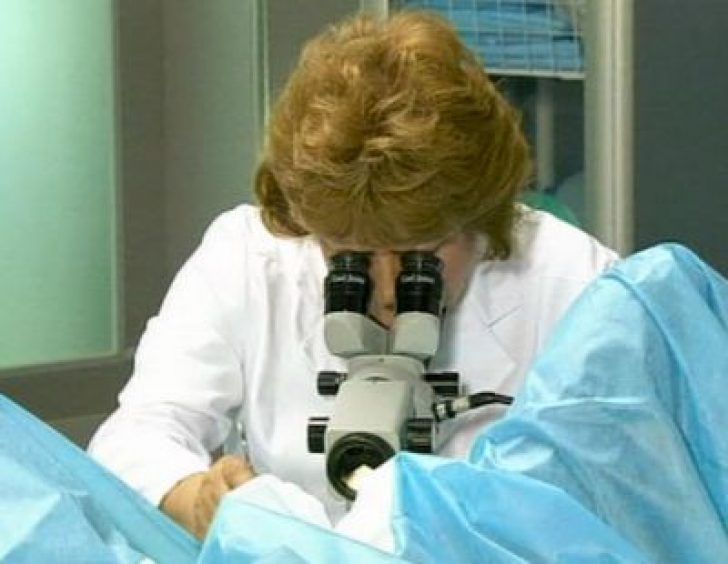 At an early stage, when the cancer is still microinvasive and is located only inside the epithelium, nothing can bother a woman. It is usually detected during a physical examination after taking a smear for a cytological examination or colposcopy.
At an early stage, when the cancer is still microinvasive and is located only inside the epithelium, nothing can bother a woman. It is usually detected during a physical examination after taking a smear for a cytological examination or colposcopy.
At the same time, the first sign of cervical cancer at an early stage may be discomfort in the genital area for no apparent reason, which should also be alarming and be a reason to contact a gynecologist. With the progression of the disease, a woman may present the following complaints from the genitals:
- bleeding not associated with the menstrual cycle of varying intensity;
- the appearance of bloody discharge after sex and during it;
- dysmenorrhea (menstrual irregularities);
- violation of urination due to compression of the ureters by a tumor (in the last stages);
- lymphostasis, that is, stagnation of lymph in the lower extremities as a result of compression of the lymphatic vessels by the neoplasm;
- watery discharge of a liquid consistency, which is formed as a result of the destruction of lymphatic capillaries in the epithelial layer by cancer;
- pain, the appearance of a bark is a sign of the spread of the process to the parameters, and compression of the nerves in the sacral region is noted;
- purulent discharge with a fetid odor is a sign of the last stage of cancer and tumor decay.
General somatic symptoms of cervical cancer are manifested by other organs and the whole organism as a whole.:
- fast fatiguability;
- , which lasts for a long time (37.5C);
- anemia;
- lack of appetite;
- increased weakness;
- fast weight loss.
Important: it is also worth paying special attention to the presence of genital warts, as they are a symptom of the human papillomavirus. They are located on the mucous membranes, and their appearance on the cervix increases the risk of getting cancer by 50 times.
Diagnostics
The establishment and confirmation of the diagnosis is based on a full examination and additional studies prescribed by the doctor:
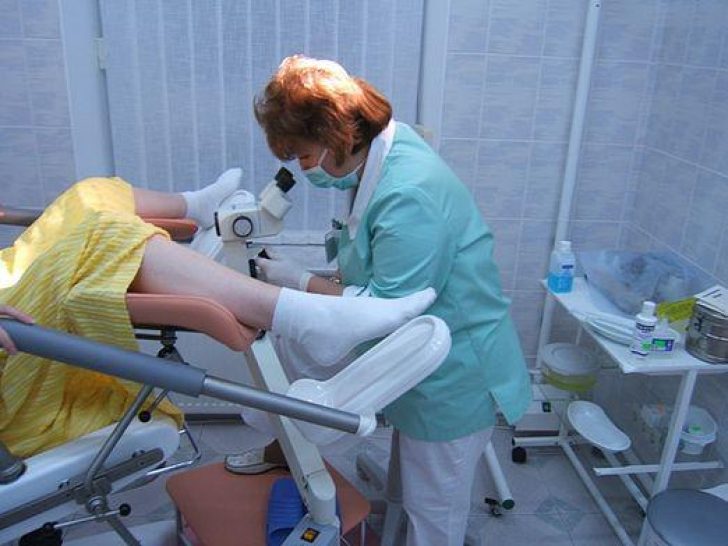
- Laboratory research:
- Cytological examination of the smear. It is taken from the cervix and stained with a special dye. When examining a smear under a microscope, atypical cancer cells are visible.
- Virological studies with virus typing and determination of its oncogenicity.
- Instrumental diagnostics:
- ultrasound. It is prescribed if necessary in some cases.
- Colposcopy. This is an optical diagnosis, in which the cervix is treated with Lugol's solution or acetic acid and examined under magnification through a colposcope. Healthy epithelium is always stained in a certain color, and cancerous epithelium does not change.
- and MRI. They are indicated for a broader diagnosis of the pelvic and abdominal organs. Tomography in this case allows you to identify the localization and parameters of the cancerous tumor, as well as the presence of metastases.
- Scraping from the cervical canal. The mucosal material obtained during this procedure is sent for histological examination.
- X-ray contrast lymphography, phlebography, arteriography. They are used as clarifying methods for detecting metastases and clarifying the degree of damage to neighboring organs.
- Biopsy. It is performed during a colposcopy. A small piece of tissue from a suspicious area of the neck is taken for histological examination.
Cervical cancer: treatment
The choice of treatment depends on the stage at which the cancer is located, the age of the woman, comorbidities, and the desire to preserve the functionality of the reproductive system.
Precancerous conditions in the form of dysplasia are treated with cryodestruction with liquid nitrogen, electrocoagulation, methods of radio wave and laser surgery. All these procedures are minimally traumatic, therefore they are well tolerated by women, and recovery after them takes up to 14 days. Traditional treatment, including hormone therapy, is also indicated.
At the stages of the cancer itself, other, more radical methods are resorted to.:
- surgical removal;
- chemotherapy;
- radiation therapy.
Surgical techniques
Cone amputation of the cervix
The cervical conization procedure is applicable for stage 0 cancer. It allows you to save the organs of the reproductive system and have a sexual life in the future. If, after this procedure, a woman is diagnosed with a fibroid or a recurrence of cervical cancer after a while, then she undergoes a complete removal of the uterus with appendages.
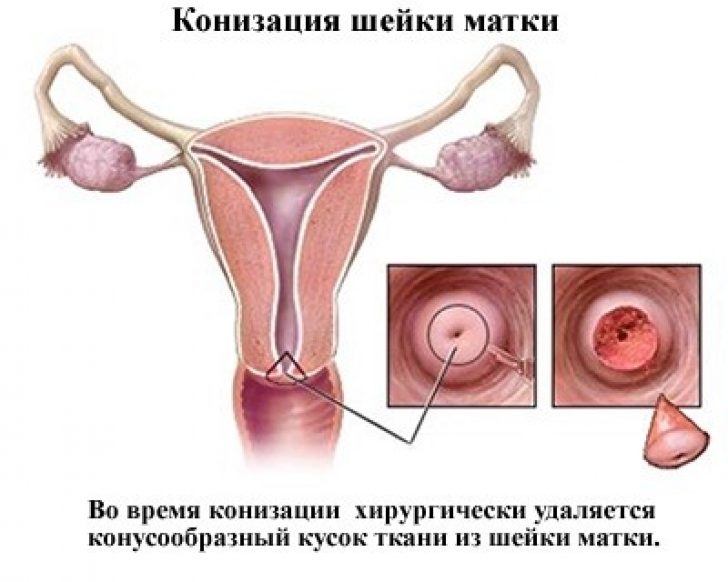 Extrafascial hysterectomy
Extrafascial hysterectomy
It is used for microinvasive type of cervical cancer. During this operation, both the body and the cervix, and sometimes part of the vagina, are removed, leaving the parametrial tissue and lymph nodes in the pelvis intact. Complete removal minimizes the risk of future recurrence and can be performed vaginally or laparoscopically.
Radical hysterectomy
This is an operation to remove the cervix, body of the uterus, part of the vagina, connective tissue around the uterus and regional lymph nodes in the presence of metastases. The ovaries are usually removed for adenocarcinoma, and for squamous cell carcinoma they are kept.
The intervention is performed laparotomically or laparoscopically. The latter is less traumatic and can be performed using robotic technology.
note: radical surgical technologies require the recovery of a woman, which can take at least 2 months. After surgery to remove the uterus and cervix, it is necessary to visit the oncologist regularly.
Radiation therapy
 It can be performed at any stage of cervical cancer, as a stand-alone treatment or as an adjunct after surgery. These types of radiotherapy are used:
It can be performed at any stage of cervical cancer, as a stand-alone treatment or as an adjunct after surgery. These types of radiotherapy are used:
- intracavitary;
- remote.
This method is used at stages 1, 2 and 3, but on condition that the tumor diameter is not more than 4 cm. The main indication for radiation therapy is the involvement of tissues that surround the cervix in the cancer process. Today, such treatment is carried out on linear accelerators with a three-dimensional planning system. The maximum effective dose of radiation is directed to the cancer area, while healthy tissues remain untouched. At the same time, radiomodifiers are also used - these are low-dose drugs, the task of which is to enhance the damaging effect of radiotherapy on the tumor.
Chemotherapy
It is usually prescribed as part of a complex treatment or when it is impossible to carry out radiotherapy, because cervical cancer is insensitive to chemotherapy drugs themselves. It is carried out with limited local spread of cancer in combination with radiation therapy, which gives good results, especially at stages 2 and 3.
It has also been proven that high efficiency is achieved during chemotherapy of squamous cell cervical cancer with platinum-based drugs. Chemotherapy drugs are taken in the form of tablets or administered parenterally (droppers). In particular, treatment with Cisplatin in combination with drugs such as Topotecan, Paclitaxel, Gemcitabine and Vinorelbine gives a good effect.
This is one of the most common female cancer problems. Cervical cancer is not difficult to diagnose. However, women often neglect their body until it completely refuses to serve them. It is worth paying attention to your individual reactions. After all, every woman with the course of life discovers those signs that speak of a disease specifically in her body. In this article, we will look at the symptoms and stages of the disease, as well as its treatment. folk remedies
Symptoms of cervical cancer
Female oncology very often remains a limited reproductive system. However, in the third stage of cervical cancer, tumor development begins in neighboring organs. Therefore, the sooner a problem is detected, the better the prognosis for treatment. Moreover, there is an 80% chance of recovery if signs of cancer are detected at the first and zero stages of the disease.
In the early stages, cervical cancer is asymptomatic. It does not cause any discomfort in general. However, there is a possibility of individual sensitivity. And women begin to experience slight discomfort, as with erosion.
With the further development of the problem, causeless and painless bleeding becomes the main indicator. Cervical cancer symptoms are caused by destruction blood vessels and have nothing to do with menstruation.
It is also possible the appearance of purulent and watery discharge. They may be an infiltrate from a tumor, or the result of a disorder of the lymphatic vessels. These secretions can provoke itching and cause obvious discomfort.
The problem is exacerbated when spotting occurs on contact. In other words, when a woman plays sports, lifts weights, or during sexual intercourse, there should be no blood. This symptom is especially alarming in cases of regular repetition.
In the third stage, when the cancer begins to affect the vagina, uterus and neighboring organs, active pain effects will begin during movement and during rest. How stronger pain, the more likely the form is running.
Stages of cervical cancer and their symptoms
The process of the course of cancer is usually divided into several stages. This is done so that with a few words you can get an idea of the patient's condition. Further in the article, we will consider the stages or degrees of the disease from the first to the fourth. In a special zero stage, a pre-invasive condition was identified, which is typical for the initial period of the onset of the problem.
Classification of stages of cervical cancer
The classification of cancer stages makes it more understandable for patients. When a doctor tells them about a particular condition, they can draw their own conclusions and make predictions for themselves. To draw adequate conclusions, it is worth learning about what stage cervical cancer is fraught with, and what ways the problem develops, in principle, exist.
The zero stage is the simplest and most quickly solved problem. Today, oncology at this level is being fought with the help of laser surgery, electrosurgery, radiation therapy, and they are doing it successfully.
The first stage of cervical cancer is the moment of damage to the connective stroma of the uterus. At this stage, treatment is also reduced to minimal measures to remove the affected tissues. Most often, after successful operations, they achieve a complete recovery of the body.
The second stage will entail more serious consequences. The fact is that at the third stage there are three options for the development of the problem, they can develop together or one at a time. At the third stage, damage to the vagina, damage to the uterus, or spread of cancer cells in parametric fiber is possible. All three options have a lot of unpleasant consequences, but they can also be experienced.
The third stage of cancer, depending on what was affected in the second stage, begins to aggravate the situation. In other words, a complete lesion of the vagina, damage to the parametric tissue up to the pelvic floor, and / or the appearance of metastases is possible.
The fourth stage of cervical cancer threatens with the development of a tumor, leads to the spread of metastases throughout the body (spine, lungs, liver), damage to neighboring organs - the bladder and intestines.
Of course, cancer, depending on the stage and affected organs, has different ways of development. Nevertheless, it is possible, necessary and necessary to fight it. Age for cervical cancer is not a hindrance, the main thing is to be aware of what is happening and fight for your health at any stage of cervical cancer. Don't lose hope and stay healthy always.
The dislocation of the tumor provokes several variations in the development of cancer. Moreover, there are options when cancer cells do not spread along one of the three possible routes, but all at once. In this case, cancer can metastasize just anywhere. The consequences of developing a tumor are terrifying. Moreover, the problem is that the first stage of the disease passes quickly, and the diagnosis comes up against already developed metastases.
Metastases as a sign of cervical cancer at different stages
Lymphatic type metastases develop first. They spread in the parametric direction, that is, along the walls of the pelvis and peritoneum. Further damage to the pelvic organs is a natural development of the disease if it develops without treatment.
Hematogenous metastases appear in the third stage, but the damage they cause is far greater degree destructive possibilities.
Metastases can grow into the uterus, although more often cervical cancer simply provokes cancer of the uterine body. The second option is the defeat of the vagina, and now it is most often captured precisely by hematogenous type metastases.
It is natural that metastases in cervical cancer affect the bladder and intestines. In this case, the intestine can be affected in two ways. If oncology develops in the direction of the vagina, then this is most often a lesion of the large intestine. If the development of troubles goes towards the uterus, then this is the small intestine.
Many people ask whether it is possible to damage the bone marrow in cervical cancer. The answer is yes. At the fourth stage of cancer, damage to the spine and bone marrow in the lumbar region is possible. Moreover, this stage is characterized by damage to the lungs and liver.
Liver damage is one of the worst options for the development of the problem. In particular, this is one of the options when a fatal outcome is possible.
It is worth knowing that cervical cancer metastasizes quickly, but the rate of their development depends on the treatment. Therefore, the sooner the treatment of the problem begins, the greater the chances for a full or partial recovery.
Treatment of cervical cancer with folk remedies
Modern medicine ruthlessly and harshly fights oncology of the female reproductive system. However, the problem of cancer did not appear today, and it was treated long before the moment when surgery or chemotherapy became possible. Folk remedies for the treatment of cancer have a decent level of effectiveness. Of course, we do not have statistics on this topic, but the fact that these funds have an effect, albeit a partial one, is for sure.
Recipes for folk remedies to fight cervical cancer
Take the pulp of 150 g of aloe vera older than three years. Pass it through a meat grinder. Then add a glass of May honey to the gruel, and half a glass of fortified red wine - better than homemade. Mix until smooth, put in a cold dark place for a couple of days. Take a tablespoon a day.
Astragalus root and / or lemon balm, brew in a ratio of one to nine and let it brew for a couple of hours. Take half a glass three times a day, half an hour before meals.
White lily root, boiled in a steam bath, in a ratio of one to five. Then they wrap the cup with a towel or pour it into a thermos and let it brew overnight. To drink for the treatment of cervical cancer, you need 200 ml of a folk remedy per day.
A decoction of chamomile, thistle, calendula can be prepared for douching in the treatment of cervical cancer. In this case, the final amount of raw materials should be equal to two tablespoons, two liters of water. Grass can simply be brewed and insisted, or you can cook it in a steam bath.
Another tip for treating cervical cancer with folk recipes is to use the above decoctions as the basis for baths. In this case, the amount of raw materials must be doubled.
Alcoholic infusion of wormwood root helps well. You can cook it yourself. To do this, the raw material must be mixed with alcohol in a ratio of one to five. Close the lid and put in a dark, cold place for a week. Take 30 drops every day in water.
You can use sea buckthorn oil for tampons against cancer. This folk remedy is worth buying at a pharmacy. Soak a tampon liberally in oil and insert it deep into your vagina. Leave the tampon on overnight.
Alcohol tinctures of common barberry in cervical cancer. Take one teaspoon three times a day.
Alcohol tinctures of ginseng, radiola rosea, propolis - will help in the treatment of cancer to increase immunity and cope with weakness.
A decoction of celandine, thistle, white cinquefoil, stinky cornflower, deceptive corydalis can be prepared like this. Pour a tablespoon of crushed raw materials with a liter of boiling water. Wrap the dishes with a decoction, and leave for a couple of hours. Then strain the decoction and drink a folk remedy for half a glass, three times a day for the treatment of cervical cancer. You can cook a decoction in a steam bath.
Useful oil infusions for tampons. You can use ready-made rosehip and sea buckthorn oils, or you can cook them yourself. To do this, you should take raw materials - one of the herbs that you used for decoctions - pour cold-pressed oil, cover with a lid and send for a week in a cold, dark place to infuse. Then drain the particles of raw materials, moisten a cotton swab in an oil infusion and insert into the vagina all night.
Douching is also useful in folk cancer treatment. You can douche with the same decoctions that you will drink. You can mix them together. You can also use chamomile, calendula, lemon balm to treat cancer. The use of nettle is strictly prohibited.
The principles of cervical cancer therapy with folk remedies
Oncology of female organs has become a very acute problem all over the world today. Huge medical centers have learned to fight cervical cancer and often give excellent results. However, there are cases when women do not fully trust doctors, but prefer alternative herbal treatment. The advantage of such treatment is that folk methods can, if not cope, then somewhat mitigate the course of the disease. In addition, the use of traditional medicine methods does not contradict the use of folk treatment.
The most important thing in the use of folk remedies is regularity and duration. The effectiveness of treatment does not appear with the speed of chemotherapy.
If the patient wants to use the treatment of cervical cancer with folk remedies in parallel with the official line of treatment, then it is worth notifying the doctor about this. He is unlikely to prohibit such procedures, and the patient will remain confident that he does not harm his body.
Very often, the treatment of cervical cancer with alternative methods helps to cope with rehabilitation after surgery and radiation therapy. The fact is that all herbs are aimed at anti-inflammatory action, which means they will help the body recover and recover faster. However, the use of traditional medicine methods should be agreed with your doctor.
Features of conventional therapy for cervical cancer
Modern drugs and technology make it possible to cope with new diseases more and more efficiently. Moreover, today the drug is being actively developed, which will allow developing a stable immunity to this problem. However, about preventive measures after. What cervical cancer treatment has today, what are its pros and cons.
Treatment methods for cervical cancer
The most common treatment for cervical cancer is surgery. Depending on the course of the disease, the operation can be performed by laparoscopy or in the form of abdominal surgery. The first treatment option is preferable, but you can’t argue with oncology and the cases are very different. Modern technologies make it possible to use not only the usual scalpel, but also an electric scalpel, a laser during surgical intervention. The latest tools promise to evolve and open up new horizons for conventional surgery.
Radiation therapy. Irradiation allows for the suppression of cancer cells. The advantage of this method is that the beam can be directed to the diseased area, and a limited number of organs will receive parallel exposure. In addition, irradiation can be of two types - intracavitary and external. Both options have their own application technologies and features. Often both methods are used at the same time.
Chemotherapy. No one canceled first-line medications. They certainly cause great damage to the body, but quite effectively fight cancer cells, and most importantly, effectively stop the spread of disease-causing cells throughout the body.
Combined method of treatment. A combination of several methods is the most common approach to solving a problem. It allows you to cope with the disease, and slightly reduce the severity of the consequences of treatment.
However, the most important thing in the treatment of cervical cancer is early diagnosis, nothing else will help to cope with cancer as effectively as possible.

